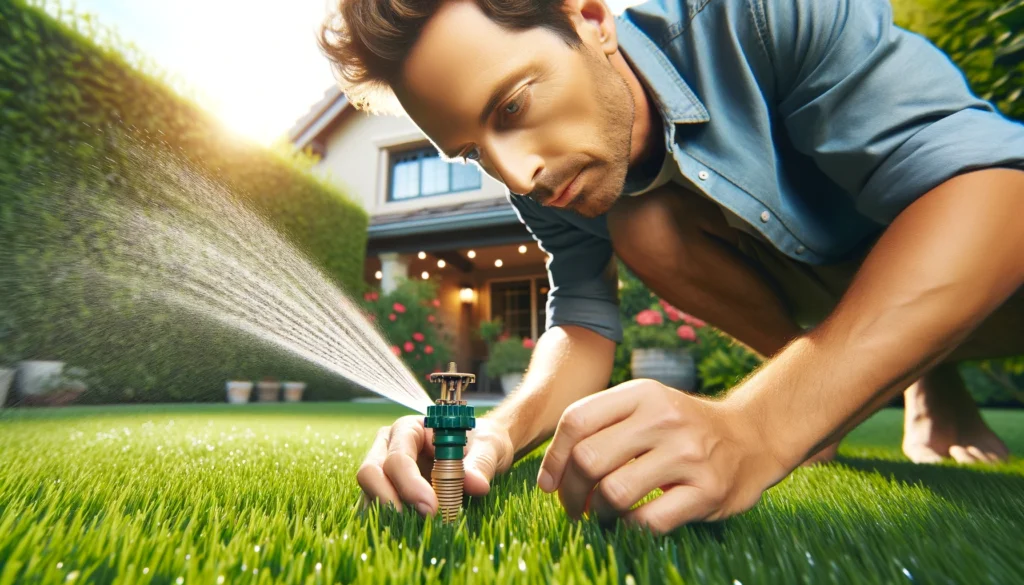Welcome to our comprehensive guide on achieving and maintaining a lush, vibrant lawn in the heart of Scottsdale, Arizona. At Three Timbers, we believe that a beautiful lawn begins with understanding the unique characteristics of your grass and implementing tailored care strategies. Whether you’re a seasoned gardener or new to the joys of lawn maintenance, this guide will provide you with the knowledge and tips needed to cultivate a stunning outdoor space.
1. Knowing Your Grass: The First Step to a Beautiful Lawn
Bermuda Grass
- Characteristics: Fine to medium texture, thrives in full sun, highly drought-resistant.
- Ideal For: Homeowners seeking a resilient and hardy lawn that withstands Arizona’s heat.
Buffalo Grass
- Characteristics: Minimal watering requirements, soft blue-green hue, warm-season grass.
- Ideal For: Eco-conscious gardeners looking for a low-maintenance, water-efficient lawn option.
Zoysia Grass
- Characteristics: Adapts to various soil types, drought-resistant, dense growth.
- Ideal For: Those desiring a versatile and robust lawn with a lush, carpet-like appearance.

2. Watering Schedule: Quenching the Thirst of Your Lawn
Watering your lawn in Scottsdale’s arid climate requires a nuanced approach to ensure your grass receives just the right amount of hydration without waste. The best time to water your lawn is in the early morning, between 4 am and 8 am. This timing reduces evaporation significantly, allowing water to soak deeply into the soil while preparing the grass for the day’s heat. It’s a simple but effective strategy to maximize water efficiency and support your lawn’s health and vitality.
Understanding the depth of watering is crucial for encouraging robust root growth, which in turn fortifies your lawn against the stresses of heat and drought. Ideally, water should penetrate 6-8 inches below the surface. This depth ensures that the roots, which are your lawn’s lifeline, have access to adequate moisture even as surface conditions become arid. Achieving this requires a slow and steady watering process, which might mean adjusting your irrigation system to run longer but less frequently.
Adjusting the frequency of watering throughout the year is key to adapting to seasonal changes in temperature and precipitation. During the hot summer months, watering 2-3 times a week supports the grass when it’s most vulnerable to heat stress. As temperatures cool in the fall and winter, reducing watering to once a week helps prevent over-saturation and conserves water. This flexible schedule ensures that your lawn receives the hydration it needs to thrive throughout the year, adjusting as necessary to the rhythms of Scottsdale’s desert climate.

3. Checking Lawn Irrigation: Essential for Efficient Water Use
Ensuring the efficiency of your lawn’s irrigation system is pivotal in maintaining a lush, healthy landscape, particularly in the water-conscious environment of Scottsdale, Arizona. Regular inspections of your sprinkler heads are a cornerstone of this process. Over time, these can become damaged or misaligned, leading to uneven watering or wasteful overspray onto pavements and non-landscaped areas. By periodically checking and adjusting your sprinklers, you can guarantee that water is being utilized where it’s needed most, ensuring every drop goes towards nurturing your lawn.
Another critical aspect of irrigation efficiency involves monitoring for signs of pooling water. Standing water indicates that certain areas of your lawn are receiving too much moisture, which can be a symptom of low spots in your yard or a leak in your irrigation system. This not only wastes water but can also lead to lawn health issues, such as root rot or fungal diseases. Identifying and addressing these issues promptly can prevent water wastage and protect the integrity of your lawn.
Moreover, the role of the irrigation controller in efficient water use cannot be overstated. As the seasons change, so too should the duration and frequency of your watering schedule. Many homeowners set their irrigation controller at the beginning of the warm season and forget to adjust it as weather conditions evolve. Regular monitoring and adjusting of the controller, based on current weather patterns and the specific needs of your lawn, can lead to significant water savings and contribute to a healthier, more vibrant lawn. By being proactive about irrigation checks and maintenance, you not only conserve valuable water resources but also create a more resilient and beautiful landscape in the challenging Scottsdale climate.

4. Mowing Heights and Timing: Key to a Healthy Lawn
Mowing is not just about keeping your lawn at an aesthetically pleasing height; it’s a critical component of healthy lawn care, especially in the challenging climate of Scottsdale, Arizona. The height at which you mow your grass can significantly impact its health, drought resistance, and ability to outcompete weeds. For Bermuda Grass, maintaining a height of 1-1.5 inches during the summer and slightly higher in cooler months encourages deep root growth and resilience. Buffalo Grass thrives at a taller 2-3 inches, which helps retain moisture and resist heat stress. Zoysia Grass, known for its dense growth, performs best when kept at 1-2 inches, fostering a lush, carpet-like appearance.
Selecting the right mower is equally important to achieving the perfect cut. A reel mower, often recommended for Bermuda and Zoysia grasses, provides a clean, precise cut, enhancing the lawn’s health and appearance. For Buffalo Grass, a rotary mower can be more suitable due to its ability to handle higher mowing heights. Regardless of the type, ensuring that mower blades are sharp is crucial; dull blades can tear the grass, leading to stress and increased susceptibility to disease and pests. Regular blade sharpening or replacement is a simple yet effective step in lawn maintenance that promotes healthy growth and recovery.
Timing and frequency of mowing are pivotal for lawn vitality. The best times to mow are during the early morning or late afternoon, avoiding the intense midday heat which can stress the grass and inhibit recovery from the cutting process. Moreover, adhering to the one-third rule — never removing more than one-third of the grass blade length in a single mowing — helps prevent shock and keeps your lawn robust. This approach may necessitate adjusting your mowing schedule throughout the growing season, with more frequent mowing during periods of rapid growth and less during times of dormancy or extreme heat.
How often you mow is determined by the growth rate of your lawn, which in turn is influenced by the season, grass type, and watering and fertilization practices. In Scottsdale’s peak growing seasons, this might mean mowing once a week to maintain optimal height and health. During slower growth periods, bi-weekly or even monthly mowing might suffice. This flexible approach ensures that your lawn isn’t stressed by over or under-mowing, maintaining its green, lush appearance while conserving water and energy. Proper mowing practices, when combined with strategic watering, fertilization, and aeration, form the cornerstone of a comprehensive lawn care program, ensuring your Scottsdale lawn remains a source of pride and enjoyment.
5. Fertilization Schedule: Nourishing Your Lawn
Fertilization plays a pivotal role in maintaining a vibrant and healthy lawn, especially in the unique desert climate of Scottsdale, Arizona. Proper fertilization provides your grass with essential nutrients necessary for growth, color, and resilience against stress and pests. The key to successful fertilization lies in understanding the needs of your specific grass type and the timing of nutrient application throughout the year.
For Scottsdale lawns, the fertilization schedule should kick off in spring, as the grass begins to wake from its dormant winter state. Applying a nitrogen-rich fertilizer at this time jumpstarts growth by replenishing the soil with nutrients depleted over the cooler months. As we move into early summer, transitioning to a balanced fertilizer supports sustained health and vigor, supplying an equal mix of nitrogen, phosphorus, and potassium to meet the grass’s growing needs.
By late summer, an iron-rich fertilizer becomes crucial to maintaining the lush green hue of your lawn, even as temperatures soar. Iron supplements help the grass produce chlorophyll, the molecule responsible for photosynthesis and that vibrant green color we all strive for. As fall approaches, shifting to a potassium-rich fertilizer prepares your lawn for the cooler months ahead. Potassium strengthens the grass’s root system, enhancing its ability to withstand cold and disease.
It’s important to select the right type of fertilizer for your lawn, considering both the grass type and the soil’s existing nutrient levels. Slow-release granular fertilizers are often recommended for their ease of use and gradual nutrient release, which feeds the lawn over several weeks and reduces the risk of fertilizer burn. Organic fertilizers, derived from natural sources, can improve soil health over time, encouraging beneficial microbial activity. Whichever type you choose, ensure to follow the manufacturer’s application guidelines and local regulations regarding fertilizer use. By adhering to a thoughtful fertilization schedule and selecting appropriate products, you can achieve a lush, resilient lawn that enhances your home’s curb appeal and provides a beautiful, green oasis in the Scottsdale landscape.
6. The Art of Aeration: Ensuring Soil Health
Aeration is a critical, yet often overlooked, aspect of lawn care that ensures the long-term health and vitality of your lawn, particularly in the compacted soil conditions typical of Scottsdale, Arizona. This process involves perforating the soil with small holes to allow air, water, and nutrients to penetrate the grass roots. Aeration helps alleviate soil compaction, which can prevent proper circulation of air, water, and nutrients within the soil. By breaking up compacted soil, aeration encourages deeper root growth and enhances the efficiency of irrigation and fertilization by facilitating deeper penetration. This leads to a lawn that is more drought resistant, more efficient in nutrient uptake, and better equipped to fend off pests and diseases.
The benefits of aeration are most apparent when it’s done at the right time and under the right conditions. For lawns in Scottsdale, the optimal aeration period is during the growing season, when the grass can heal and fill in any open areas after soil plugs are removed. This usually falls in spring or early summer for most grass types found in Arizona.
Aeration Tips:
- Timing: Best performed during the growing season for rapid recovery of the lawn.
- Frequency: Active lawns benefit from annual aeration, while less trafficked areas may only need it every 2-3 years.
- Equipment: Use a plug aerator for the best results, as it removes a core of grass and soil from the lawn.
- Post-Aeration Care: After aeration, it’s an excellent time to apply fertilizer and overseed if necessary, as the soil is more receptive.
- Irrigation: Water your lawn a day before aerating to soften the soil, making the process more effective.
Implementing aeration into your lawn care routine can significantly improve soil structure and lawn health, creating a more lush and resilient outdoor space.
7. Removing Thatch: Maintaining a Breathable Lawn
Thatch removal is an essential aspect of maintaining a healthy, breathable lawn. Thatch, a layer of dead grass, roots, and debris that accumulates on the soil’s surface, can hinder water, nutrients, and air from reaching the soil and, by extension, the grass roots. Removing this layer through dethatching revitalizes your lawn, allowing it to breathe and absorb essential resources more effectively. This process promotes stronger root systems and a more vigorous lawn overall, especially crucial in the challenging climate of Scottsdale, Arizona, where every bit of water and nutrient is valuable for lawn sustainability.
Thatch Removal Tips:
- Identify the Need: Regularly check for thatch buildup; more than 1/2 inch indicates it’s time to dethatch.
- Choose the Right Time: Early spring or early fall, during your lawn’s growing season, is ideal for dethatching.
- Select Proper Tools: Use a dethatching rake for small areas or a power dethatcher for larger lawns.
- Follow-Up Care: After dethatching, water and fertilize your lawn to encourage recovery and regrowth.
- Consider Aeration: In cases of severe compaction, follow dethatching with aeration to maximize soil health improvement.
8. Keeping Summer Weeds at Bay: A Proactive Approach
Combatting summer weeds in Scottsdale, Arizona, requires a proactive and strategic approach due to the region’s unique climate conditions. The key to effective weed control lies in preventing their emergence and swiftly addressing any outbreaks that occur. Pre-emergent herbicides are an essential tool in this endeavor, creating a barrier in the soil that inhibits weed seed germination. Application in early spring, before temperatures rise and weed seeds begin to germinate, can significantly reduce the weed population throughout the summer. For existing weeds, post-emergent herbicides targeted at the specific weed type can be effective. Choosing the right product and applying it correctly is crucial for minimizing weed competition and ensuring the health and beauty of your lawn.
When selecting herbicides, it’s important to consider the specific needs of your lawn and the types of weeds you’re combating. Products containing Dimension (dithiopyr) or Prodiamine are popular choices for pre-emergent control and are effective against a wide range of grassy and broadleaf weeds. For post-emergent control, herbicides with 2,4-D or dicamba can target broadleaf weeds without harming your grass. Always read and follow the product labels for application rates and timing to maximize effectiveness and minimize harm to your lawn.

Pre-Emergent Application Tips:
- Timing: Apply in early spring, before soil temperatures consistently reach 55°F.
- Spreading: Use a broadcast spreader for granular formulas or a tank sprayer for liquid concentrates.
- Watering-In: After application, lightly water your lawn to activate the herbicide.
Post-Emergent Application Tips:
- Spot Treatment: Apply directly to visible weeds, avoiding unnecessary exposure to the rest of the lawn.
- Repeat Applications: Some weeds may require multiple treatments; follow the label for guidance on intervals.
- Safety: Wear protective clothing and avoid application on windy days to prevent drift.
Regular lawn maintenance practices, such as proper mowing, watering, and fertilization, also play a vital role in weed control by promoting a dense, healthy turf that resists weed invasion. Incorporating these methods with the strategic use of herbicides creates a comprehensive weed management strategy. By taking a proactive stance on weed control, you can enjoy a lush, vibrant lawn that enhances your outdoor living space and stands as a testament to your dedication to lawn care excellence.
Conclusion
In summary, achieving a lush, vibrant lawn in Scottsdale, Arizona, is a multifaceted endeavor that requires a keen understanding of your grass type, diligent watering and fertilization practices, and proactive maintenance strategies. From selecting the right grass for your landscape, ensuring it receives the correct amount of water, to nourishing it with the appropriate fertilizers at the right times of the year, each step is crucial in cultivating a healthy lawn. Regular aeration and thatch removal further enhance soil health, allowing your lawn to breathe and absorb nutrients effectively. Combating weeds with a proactive approach ensures your lawn remains pristine and inviting. By adhering to these guidelines and incorporating the recommended practices into your lawn care routine, you can create a beautiful outdoor space that thrives in the unique Arizona climate, providing enjoyment and curb appeal all year round.

